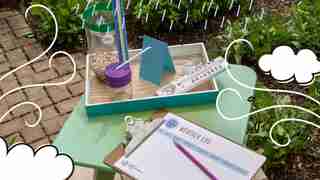Weather Station
Build your own weather station to record weather events that happen in your own backyard!
Barometer
Materials
- Small jar or cup, like a juice glass or yogurt container
- Balloon
- Tape
- Index card or piece of thick paper
- Straw
- Rubber band
- Scissors
- Pen or pencil

Directions
Cut the neck off a balloon, stretch the balloon over the top of a jar or small cup and secure it with a rubber band. Cut a straw in half and cut at an angle to make a point. Tape the straw to the balloon so the end is in the center and the pointed end extends over the edge of the jar or cup. Place tape over the full length of the straw that's on the balloon so that it's secure. Make a gauge by folding an index card in half (or taping two together in a V shape) so that it stands next to the straw. The card should be about twice as tall as the jar. Mark on the index card gauge the location where the straw points each day.
Rain Gauge
Materials
- Plastic bottle, 1- or 2-liter (with straight, not curved, sides)
- Gravel
- Ruler
- Tape
Directions
Cut off the top fourth of your plastic bottle. Add about two inches of gravel to the base of the bottle. Tape a paper ruler on the outside of the bottle, with the "0" mark at the top of the gravel. Add water until it reaches the top of the gravel. Make a funnel by inverting the top of the bottle that you cut off, placing it inside the base and covering the cut edges with tape. When it rains, measure the rainfall amount on the ruler.
Anemometer
Materials
- String
- Ping pong ball
- Scissors
- Tape
- Protractor (you can use this protractor template)
Directions
Tape one end of a piece of string to a ping pong ball and the other to the center of the straight edge of a protractor. Hold the anemometer with the straight edge on top, parallel to the floor. Note the angle of the string when the wind blows, then use it to calculate the wind speed. Check the chart on our protractor template for this calculation.
General materials
- Thermometer
- Tray or box
- Weather log
What's happening?
Weather describes the temperature, humidity, atmospheric pressure, wind, rainfall and other meteorological characteristics of the atmosphere in a specific place at a specific moment in time. Instruments help measure the weather. A barometer measures air pressure; low or falling pressure (when the straw points downward) means a storm is approaching, while high or rising pressure (when the straw points up) means sunny weather. A rain gauge measures how much rain falls at a time. An anemometer measures the speed of the wind.
Extensions
Collect data for an extended period of time. Note the daily temperature and observations of what you see outside (sun, clouds, etc.). Guess what tomorrow's weather will be by using the patterns you have observed from your weather station. You can even make a video forecast like a TV meteorologist, then check the next day to see if you were correct.
Recommended reading
Down Comes the Rain by Franklyn M. Branley
Magic School Bus Presents: Wild Weather by Sean Callery
These education materials were prepared by the Museum of Science and Industry under award NA16SEC0080001 from the Environmental Literacy Grant (ELG) Program of the National Oceanic and Atmospheric Administration (NOAA), U.S. Department of Commerce. The statements, findings, conclusions, and recommendations are those of the author(s) and do not necessarily reflect the views of NOAA or the U.S. Department of Commerce.